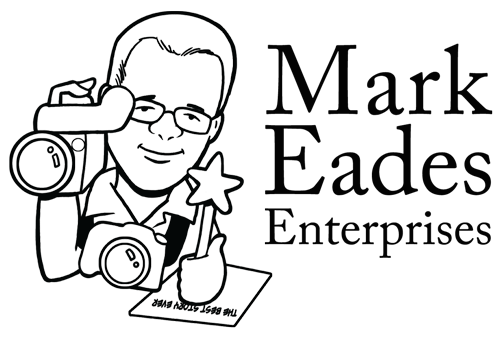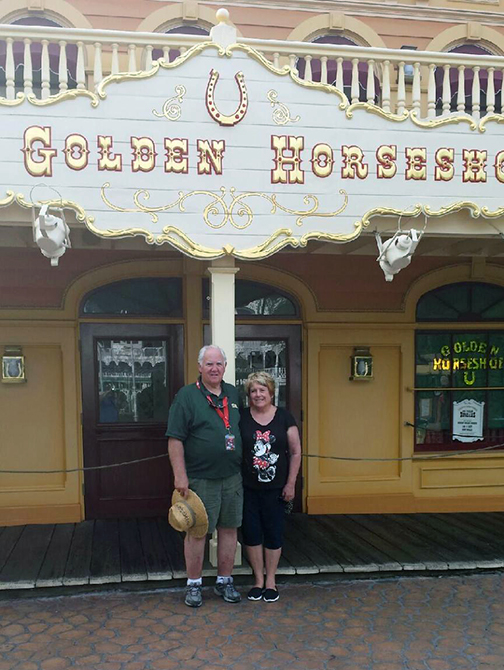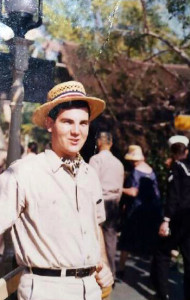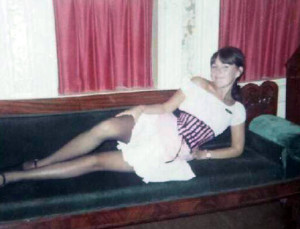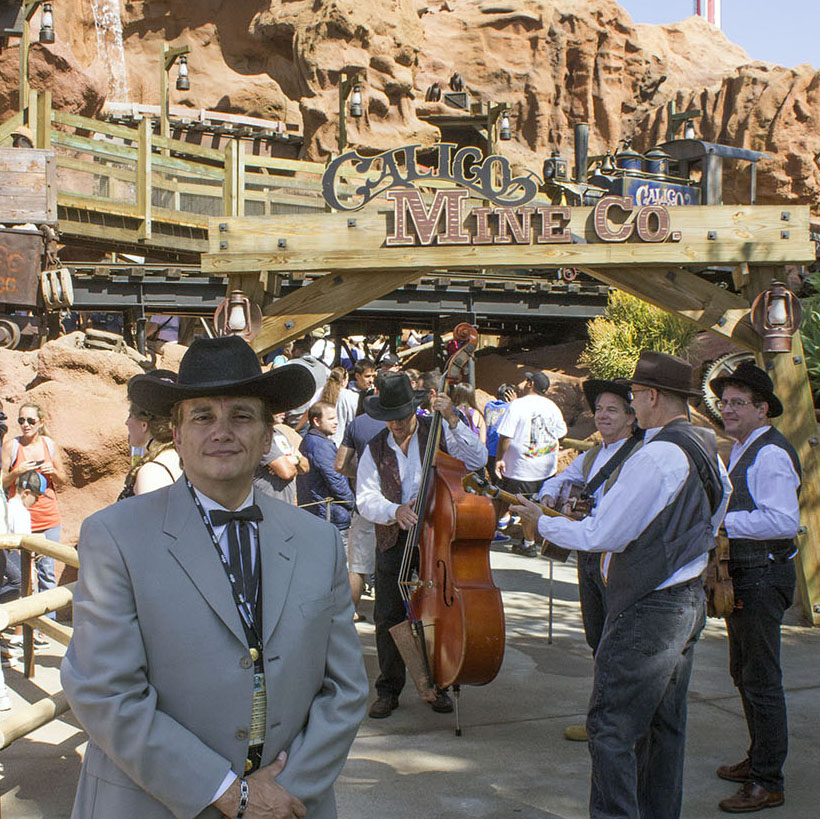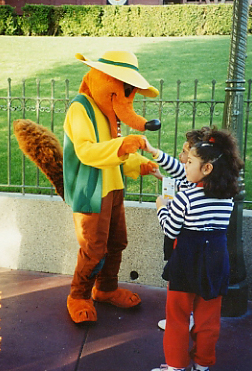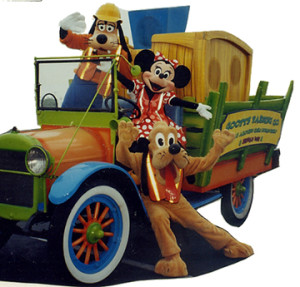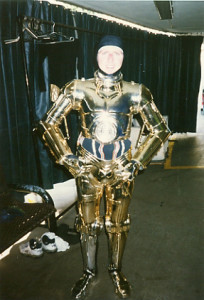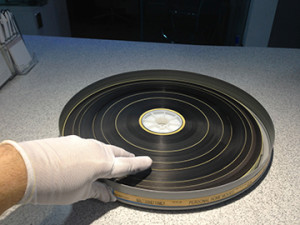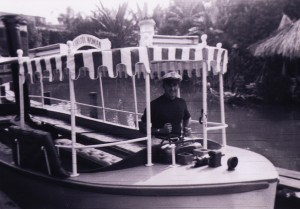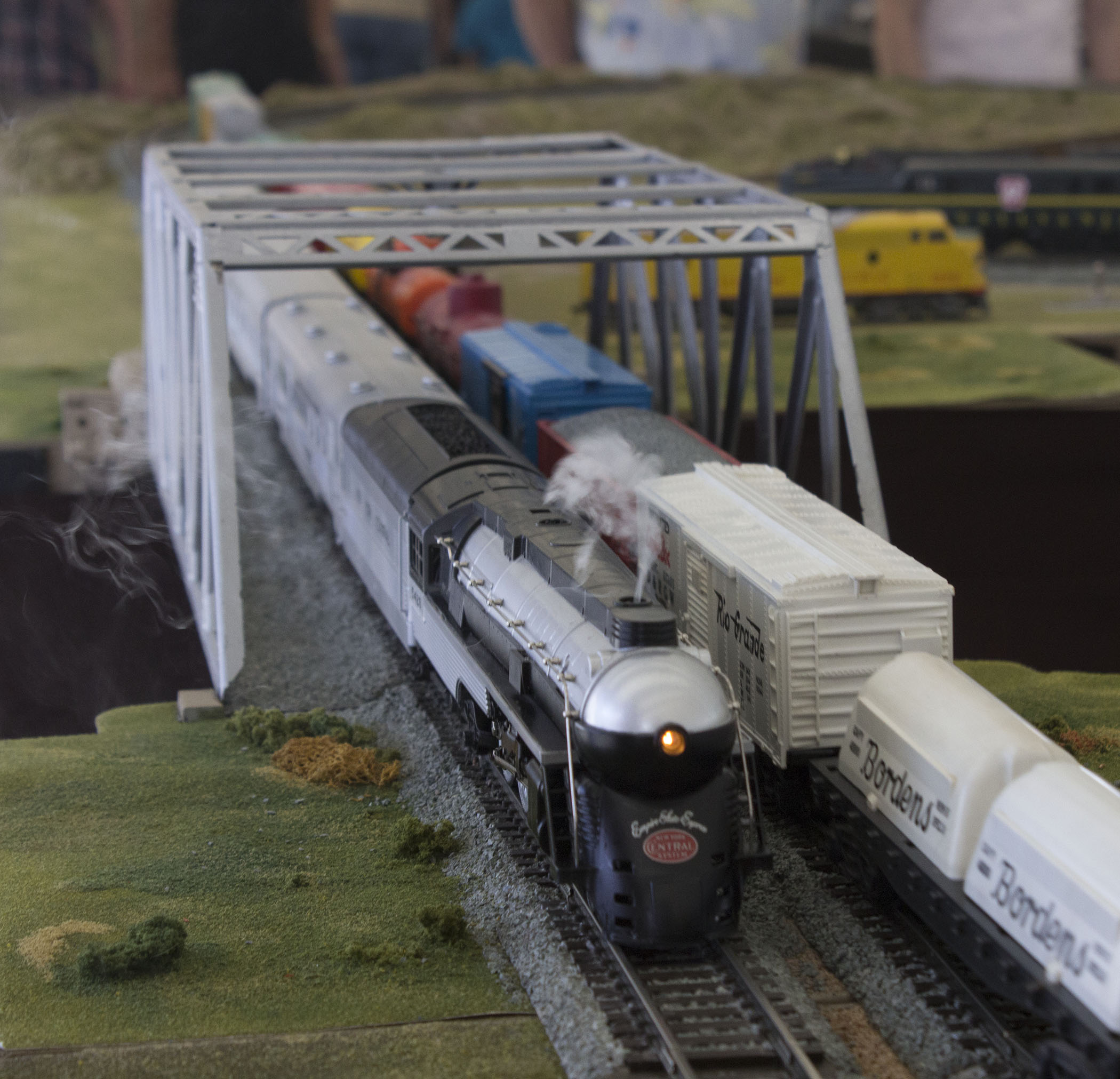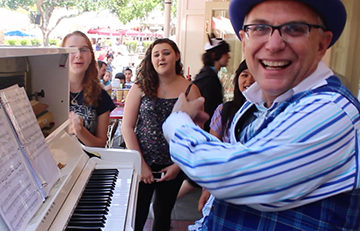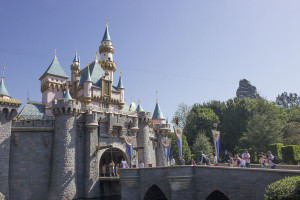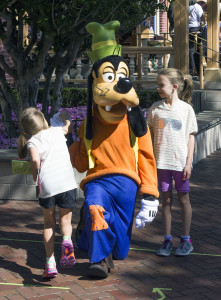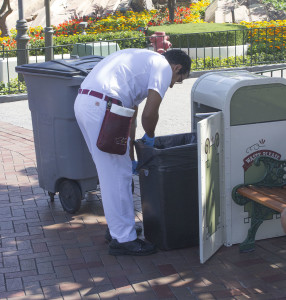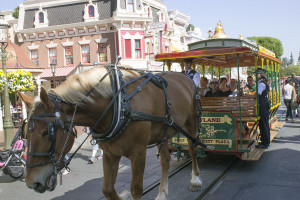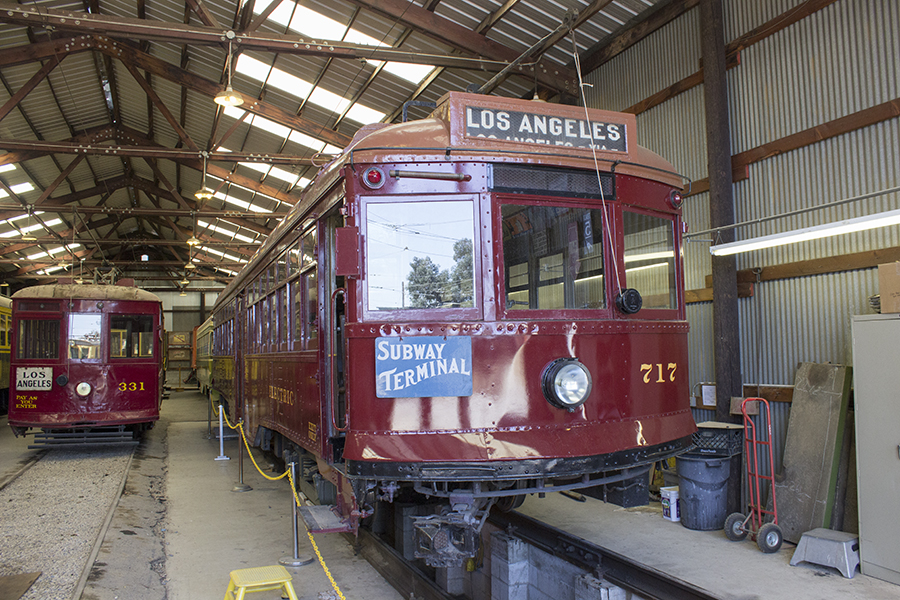I went to see the 90th edition of the Anaheim Halloween Parade Saturday night, October 25, 2014. Classic fun community parade. There were a few bands, some silly floats and other fun stuff. Enjoy.
Disneyland
Carl Casebeer’s Disneyland story started the same day the park opened, on July 17, 1955. No, he wasn’t one of the first cast members. He was a second grader at a local school in Anaheim. His class and many others were invited to the park for opening day. So they boarded buses and were off on an adventure into this new place on Harbor Boulevard. “I spent the whole time in Fantasyland. We were not allowed to go to the other lands,” Carl said.
The memory of that opening day stuck with him so much that when he turned 18 and was finishing up at Anaheim High School, he applied for and got a job at Disneyland, starting with cracking jokes as a skipper on the world famous Jungle Cruise in 1965. Two years later, he was part of the opening crew for Pirates of the Caribbean.
“I really enjoyed working on Pirates,” Carl said, admitting to occasionally joining fellow cast members in pulling a prank on park guests. “We would go out into the ride and stand there like we were one of the Audio-Animatronics pirates. The Tour Guides knew who we were and would point us out,” he said. Somehow, they didn’t get in trouble for that
It was a different story while working on the Mine Train Through Nature’s Wonderland. “I got my only reprimand there when I derailed a train once because I threw the switch at the wrong time.” (No one was hurt in the incident.)
Eventually, he worked on every attraction in Adventureland and Frontierland, including stints as foreman on both shooting galleries. One day, while working at the Adventureland Shooting Gallery, Walt Disney brought his grandson over to shoot. “I didn’t get money or a C coupon from him, so I was short that night.”
A few years later, while working as foreman of the Mark Twain and Columbia Sailing Ship, his sharp eyes saw something he liked. “I spotted a beautiful girl at the entrance to the Golden Horseshoe Review. She had a short dress on and cut an attractive figure. I kept seeing her over there, so I asked the Horseshoe’s foreman about her availability. Turned out she was not taken, so I asked her out.”
That girl was Sue Anderson, who had gotten the job after showing off her legs.
“They made me stand up and show them my legs when I was being hired to see if I could work at the Golden Horseshow,” she said. (At the time, the costumes for female food hostesses at the Horseshoe were short skirts.)
Working at the Horseshoe could be a challenge. “One time I dropped a whole tray of cups filled with Pepsi on a guest,” Sue recalled. Another time while cleaning up on the upper level after a show, Sue says she found somewhat startling evidence that a couple up there had been doing more than just watching the show.
Carl and Sue’s first date was at a small employee party held in Frontierland. “I knew she was a good catch when she let me finish her steak on that date,” Carl said. They kept dating and Sue kept waiting tables at the Horseshoe. She eventually left to work as a flight attendant at Western Airlines but that lasted less than a year, as they married on August 22, 1970. “I was always on call, and I was getting married and they (the airlines) discouraged it (marriage) at that time,” she said.
Carl stayed at Disneyland and went on to become an assistant supervisor for Attractions in Tomorrowland. In 1974, he left Disneyland to become a Fotomat manager and eventually went into pharmaceutical sales—a career that lasted 30 years until 2010.
For many years, Sue created homemade ceramic souvenirs, some of which (ceramic chess sets) were even sold at Disneyland. She now makes sculptural jewelry that she and Carl sell at art shows in Oregon, where they have lived for years. Samples of her current work can be found at thegreengypsy.vpweb.com.
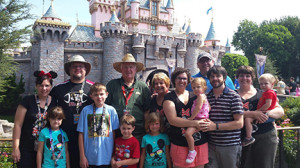
Carl and Sue Casebeer and family at Disneyland for a reunion on the occasion of their 44th anniversary during the summer of 2014.
Sue made enough money from her jewelry sales to pay for a special trip to Disneyland this year (2014) for their 44th anniversary—a trip that featured a reunion with most of their extended family, including three children and six grandchildren, inside Walt Disney’s original Magic Kingdom. Of course, they had to take the whole family on The Jungle Cruise, where they all tried to get Carl to do his old spiel, but he claimed the attraction had changed too much. “We had a fantastic skipper on the ride. Even our five-year-old grandchild, William, liked it,” Carl said.
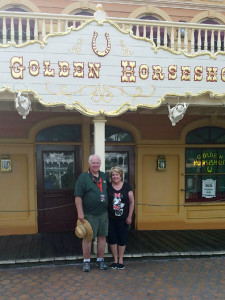
Carl and Sue Casebeer met at Disneyland while both were working in Frontierland. Him on the Mark Twain, her at the Golden Horseshoe.
The couple is already planning a Disney family reunion for their 50th anniversary in 2020. “We’re going to try and get everyone to Disney’s Aulani Resort in Hawaii,” Sue said. For the Casebeers, it’s been a truly Disney life.
This profile is part of a series featuring former Disney Cast Members being written for the Disneyland Alumni Club. These stories reveal the role working for Disney has played over the years in shaping the lives of the people who help “make the dream a reality,” as Walt would say.
In honor of the 60th anniversary year of Disneyland in 2015, the Disneyland Alumni Club is reaching out to former employees, whether retired or younger, who may not be aware of the organization. The Club was started in 1983 by Disneyland executives Van France and Dick Nunis as a way to help Cast Members stay in touch after moving on to other careers. Is that you? If so and you’d like to take part in the Club’s private celebration next August—or participate in their many other activities and benefits, please visit www.disneylandalumni.org and join today!
Here’s some previous stories about Disneyland Alumni:
Former Cast Member Remakes Heavenly Music
Lifelong bonds formed working at Disneyland
Caretaker of Walt Disney’s Family Film Legacy
This article and photographs are copyright 2014 by Mark Eades, all rights reserved. Used by permission. Photographs supplied by subjects are used by permission, all rights reserved.
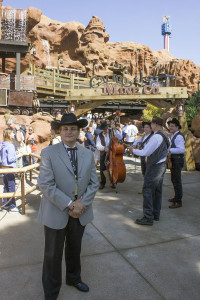
Bill Reyes, a theme park aficionado and Disneyland Alumni, digitally recreated the music heard in the heaven caverns room inside the Calico Mine Train Ride at Knott’s Berry Farm.
Music, trains, and theme parks are passions of Bill Reyes, and he’s found a way to work all three into his life. Unusually enough, it began when Bill’s dad learned his young son preferred music to sports—and rather than lose heart at not having a future athlete in the family, he encouraged Bill’s love of music.
Bill’s dad gave him records by Duke Ellington, Buddy Rich, and Count Basie, sparking his first musical love—drums and percussion instruments. Bill learned to play and kept playing for many years.
“Once I hit high school, the band director there introduced me to various other instruments including all the horns and reed instruments,” Bill said. His music passions grew to include guitar, keyboards, and more, eventually recording and producing music in his own studio at his house.
But music was not always a good source of income for a person with a family, so Bill turned his hands to educational design—producing training and educational materials and programs for a variety of companies. Even while working at his day job, he still finds time for his first musical love. “I can play all night long live on drums and percussions.”
After music came trains. Bill’s childhood passion for trains was fired up by frequent trips to Knott’s Berry Farm. Back then going to Knott’s was a free place for the La Mirada family to go. “The steam engine, number 41, scared me as a kid, but I was fascinated by it,” Bill said. “I went and got books on trains and researched them a lot.”
Bill saved up so he could buy a ticket and ride not just the big steam train but also the Calico Mine Train Ride, where he heard the organ music—a piece called “Going to Heaven”—in the Cavern Room at the top of the big lift halfway through the ride. “The sound of that organ music in that room was wonderful,” he said.
Bill’s fascination with trains continued as the family began making annual August trips to Disneyland for his brother’s birthday. “I knew the first thing I’d see and smell when I got there were the trains.” Bill said it took a few trips for him to figure out there was more than one train at Disneyland, but once he realized that fact, he continued his diligent research. When he found out about Walt Disney’s affinity for steam trains and even his ownership of a scale model live steam engine, Bill began to dream about maybe working someday at Disneyland—on the steam trains, of course. “I love trains. I don’t really own any,” Bill admits, “but I love them.”
Bill’s Disneyland dream had to be tabled awhile as he worked on raising his family. Then one Sunday, just a few years ago, Bill and his son went to Traveltown in Los Angeles. They also went next door to the Los Angeles Live Steamers, and discovered Walt Disney’s Barn. During that visit, Bill met Michael Broggie, son of Disney Legend Roger Broggie and one of the members of the Carolwood Foundation, which maintains the Barn at the location. In 2009, Bill became a volunteer docent for Walt’s Barn.
Eventually, Bill joined the Carolwood Foundation and became a member of its board of directors. Now he can be found there on the third Sunday of each month, dressed in a conductor’s uniform, answering visitors’ questions.
When the last recession hit the U.S. economy, it pounded both Bill’s lines of work—hard. That’s when he applied to work at Disneyland. “I figured what the heck,” he said.
In 2011, Bill was offered a position as a Disneyland Attractions Host. After going through orientation with the Disney University, he was soon working on the west side of the park. Before long, Bill began getting calls for work back in his field, forcing him to resign his position after a few months. “I loved working at Disneyland, but there weren’t enough hours to support my family,” Bill admitted.
Meanwhile, he paid a few more visits to Knott’s Berry Farm and rode the Calico Mine Train Ride, where he found that the wonderful organ music in the Cavern Room had become less than heavenly over the years. “It sounded like it had been edited, and was very weak.”
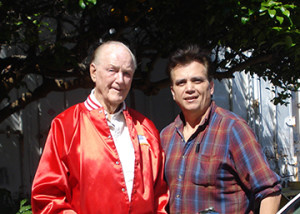
Bill Reyes (right) is pictured with Bud Hurlbut, designer of the Calico Mine Train Ride and the Timber Moutain Log Ride at Knott’s Berry Farm. Used by permission.
Bill decided it needed improving, so he paid a visit to his friend Lonnie Lloyd, who was shop foreman for the legendary ride designer Bud Hurlbut. (Bud had designed and built the Calico Mine Train Ride. Walt Disney admired Bud’s ride designs and met with him several times.) Even though Bud had passed away, Bill was able to get a copy of the original sheet music for the Caverns Room from Lonnie and set about recreating it from scratch. “I am not an organist,” Bill said. “I’m more of a technician. But I wanted to do it as a tribute to Bud.”
The original organ music had been recorded more than 50 years before on a real organ. While Bill did not have access to the original, he did have a scratchy copy of it and started working on a new recording. Because he was not an organist, Bill took more of a technical approach, recording digital samples of organ music and matching them to the sheet music on his computer. It took several months of finding and getting organ samples, plugging them in, listening, and adjusting before he finally got it finished. “I played it for Lonnie and he thought it was a new recording of the original.”
Bill’s work didn’t end there. When he heard that Knott’s Berry Farm was going to completely refurbish the ride, he wanted them to have the new recording and offered it to them gratis.
When the refurbished ride—with an all new sound system and more—debuted in June 2014, the organ music heard in the Cavern Room of the Calico Mine Train Ride is what Bill had produced, and he did it in line with all of his passions: music, trains, and theme parks.
This profile is part of a series featuring former Disney Cast Members being written for the Disneyland Alumni Club. These stories reveal the role working for Disney has played over the years in shaping the lives of the people who help “make the dream a reality,” as Walt would say.
In honor of the 60th anniversary year of Disneyland in 2015, the Disneyland Alumni Club is reaching out to former employees, whether retired or younger, who may not be aware of the organization. The Club was started in 1983 by Disneyland executives Van France and Dick Nunis as a way to help Cast Members stay in touch after moving on to other careers. Is that you? If so and you’d like to take part in the Club’s private celebration next August—or participate in their many other activities and benefits, please visit www.disneylandalumni.org and join today!
Here’s some previous stories about Disneyland Alumni:
Lifelong bonds formed working at Disneyland
Caretaker of Walt Disney’s Family Film Legacy
This article and photographs are copyright 2014 by Mark Eades, all rights reserved. Used by permission. Photographs supplied by subjects are used by permission, all rights reserved.
Some teachers in school are real characters. In Tim Strauch II’s case, he was one—a Disneyland character that is.
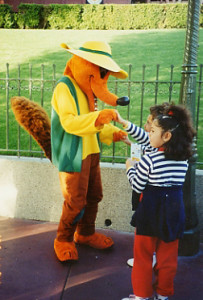
Tim Strauch II on his first day as a Disneyland character. Here he is dressed as Br’er Fox. Used by permission.
Actually Tim, 44, played several Disneyland characters during his time as a Cast Member in the Entertainment Department from November 1996 to January 2001, including Pluto, Buzz Lightyear, Tweedle Dee and Tweedle Dum, Eeyore, Rafiki, Geppetto, C3P0 and his first one, Br’er Fox.
Tim got the performing bug from his father, who was a professional clown for parties and events while also working as a teacher by day. At the age of two, Tim first visited Disneyland. Even though he lived in the Sacramento, Tim loved Disneyland so much that as a Cub Scout he sold enough “Scout-a-rama” tickets to win a free trip to Disneyland four years in a row. He even told a cousin who went with him on one trip that one day he was going to work there.
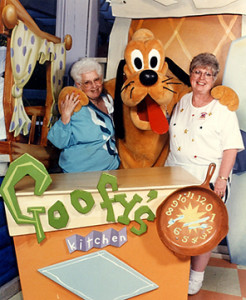
Tim Strauch II is dressed as Pluto in this photo. On the left is his grandmother, on his right is his mother. Used by permission.
In 1989, Tim submitted his first Disneyland application while attending junior college, planning to get a job there and finish his schooling at California State University, Fullerton. But that dream did not happen, so he went back home to Sacramento and attended California State University, Sacramento instead. After graduating with a degree in Communications, Media Production, he set off for Hollywood to find a career in show business.
Initially, Tim got a job in Six Flags Magic Mountain’s Character Department, while going on job interviews and auditioning for roles in television and films. Thanks to that experience, in 1996 he landed an audition to be a character at Disneyland.
“I’ve never felt more confident in an audition,” he said. He got the job and was made a Cast Member in Disneyland’s Entertainment Department. His first day as a Disneyland character on stage was his birthday in 1996, in the role of Br’er Fox.
Meanwhile, Tim continued to audition for acting roles or a position in television production, but that proved to be a struggle. “I knew it would be a hard field and I gave it my best. But I wasn’t as successful as I thought I could be,” said Tim.
Tim had done some teaching side by side with his dad, Tim Strauch, Sr. and decided it was fun, so he went back to school to get his teaching credential. He moved back up north, and started teaching at Community Outreach Academy Elementary School in McClellan, California, where he lives today with his wife of 14 years. As a teacher, he’s received a Teacher of the Month award handed out by the local ABC News affiliate, along with other honors.
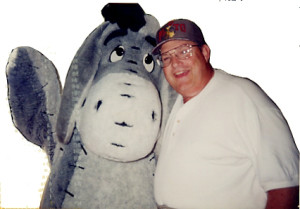
Tim Strauch II is dressed as Eeyore, and is pictured with his father, Tim Strauch I. Used by permission.
But Disneyland is still in his heart and he fondly remembers his time in his many Disney character roles. “The experience is one that will never leave me,” he said. “I wear my Disneyland Entertainment ring everyday and I’m proud to say I worked there.”
This profile is part of a series featuring former Disney Cast Members being written for the Disneyland Alumni Club. These stories reveal the role working for Disney has played over the years in shaping the lives of the people who help “make the dream a reality,” as Walt would say.
In honor of the 60th anniversary year of Disneyland in 2015, the Disneyland Alumni Club is reaching out to former employees, whether retired or younger, who may not be aware of the organization. The Club was started in 1983 by Disneyland executives Van France and Dick Nunis as a way to help Cast Members stay in touch after moving on to other careers. Is that you? If so and you’d like to take part in the Club’s private celebration next August—or participate in their many other activities and benefits, please visit www.disneylandalumni.org and join today!
Want to read articles about some other Disneyland Alumni? Click on the links below.
Lifelong bonds formed working at Disneyland
Caretaker of Walt Disney’s Family Film Legacy
This article and photographs are copyright 2014 by Mark Eades, all rights reserved. Used by permission. Photographs supplied by subjects are used by permission, all rights reserved.
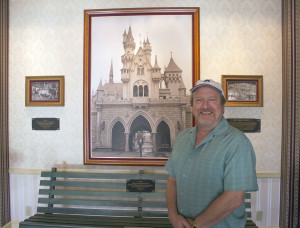
Scott Zone, the official archivist of the Disney family home movies, stands in front of a bench from Griffith Park at Disneyland.
If you’re a fan of the Walt Disney Family Museum and all the great videos featuring Walt Disney and his family on display there, then you have Scott Zone to thank for how great they look—and it all started in 1995.
At that time, Scott was working at Orion as a colorist in video post-production when he was recommended to the Disney family for a very special project. “Diane and Ron Miller wanted all of Walt Disney’s home movies transferred to video, color corrected and restored,” Scott said.
So Scott was engaged to make that dream a reality, involving many reels of film. He restored the quality and color as best he could, using the technology available at the time. Walter Miller, Walt Disney’s grandson and co-founder of the museum, would come in each week to review the progress and view all the imagery.
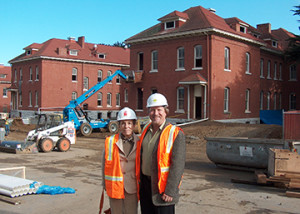
Scott Zone, the conservator and archivist of the Disney family home movies, stands with Diane Disney Miller, the only natural daughter of Walt and Lillian Disney, outside the Walt Disney Family Museum while it was under construction. Photo used by permission from Miller family and Scott Zone.
When all the movies had been transferred Walt’s daughter, Diane Disney Miller, came in and sat with Scott to look at them, movies that featured her, her father and mother, her sister, and many other friends and family members.
“Diane started narrating them live. I wish I had had a recorder at the time. It was fascinating to hear her talking about what we were seeing on the monitor as if we were there,” said Scott. Scott transcribed much of the imagery and cataloged it for the family, and then he was done. The films were returned to a refrigerated vault in Hollywood.
Then a decision was made to produce a film using much of that footage in a 2001 documentary called, “Walt: The Man Behind the Myth,” directed by Jean-Pierre Isbouts, working with the family members. Scott became the liaison for the family with the filmmakers as they went through all the hours of footage for use in the film.
But Scott was soon going to be involved in much, much more when Diane tapped him to help out with the planned museum dedicated to telling her father’s story. In 2005, he got a call from Walter telling him about the concept. The initial thinking, Walter told him, was to use the home movies throughout. “Since technology had changed, I suggested re-transferring everything to HD (High Definition Video). So we redid the whole library.”
Because of Scott’s intimate knowledge of the home movies, Walter invited him to participate in some of the concept and design discussions the family was having with other designers, some of whom were former Disney Imagineers such as Jeff Kurtti and Bruce Gordon.
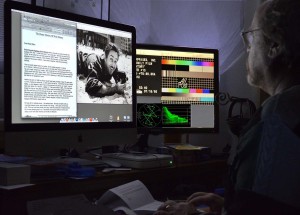
Scott Zone works on transcribing Walt Disney’s home movies. Copyright by Scott Zone, used by permission.
After the museum opened, Scott was retained to make a more detailed transcript of what was contained in the footage. He went through each frame trying to identify the people visible or the location where it was shot. Many times he would work directly with Diane to come up with the information on footage that had been shot 60 years or more ago.
“I really enjoyed working with Diane. She was a wonderful lady and wanted people to know the true story about her dad,” Scott said. (Editor’s note: Diane passed away in November, 2013 at the age of 79.)
Even now, Scott is occasionally called on to put together some of the material for museum events. In 2011, the Disney grandchildren born during Walt’s lifetime participated in an event called, “Our Grandpa, Walt Disney.” For this project, Walter asked Scott to edit a video using the home movies that showed the grandkids with their famous grandfather.
Currently, Scott is working on a documentary about Walt Disney for PBS and also does speaking engagements for the museum. In addition, Scott works on projects for other clients as a colorist, archivist, author of Blu-Ray DVDs and more. Meanwhile, he is the steward of the legacy that is the home movies of one of the most creative people in United States history. “I want to make sure this important footage of this wonderful man is preserved forever.”
This profile is part of a series featuring former Disney Cast Members being written for the Disneyland Alumni Club. These stories reveal the role working for Disney has played over the years in shaping the lives of the people who help “make the dream a reality,” as Walt would say.
In honor of the 60th anniversary year of Disneyland in 2015, the Disneyland Alumni Club is reaching out to former employees, whether retired or younger, who may not be aware of the organization. The Club was started in 1983 by Disneyland executives Van France and Dick Nunis as a way to help Cast Members stay in touch after moving on to other careers. Is that you? If so and you’d like to take part in the Club’s private celebration next August—or participate in their many other activities and benefits, please visit www.disneylandalumni.org and join today!
Want to read articles about some other Disneyland Alumni? Click on the links below.
Lifelong bonds formed working at Disneyland
This article and photographs are copyright 2014 by Mark Eades, all rights reserved. Used by permission. Photographs supplied by subjects are used by permission, all rights reserved.
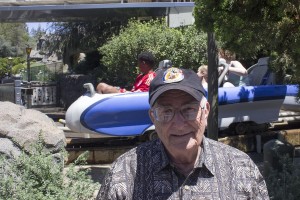
At one time in his Disneyland career, John Waite worked as an Attractions Host, though they were called Ride Operators in the early days, on the Matterhorn Bobsleds.
“I have always loved amusement parks,” John Waite told me. It’s a love affair that started when he was a kid growing up in Cleveland and stuck with him while studying theater at nearby Allegheny College—so much so that he worked at Euclid Beach Park (an amusement park on the southern shore of Lake Erie that opened in 1895 and closed in 1969) from 1947 until he graduated in 1951.
Near the end of his four-year stint in the Air Force (he was in the Intelligence field and cannot divulge exactly what he did!), John heard Walt Disney was building a theme park in California. “I told the family I was moving to California and was going to work for Walt Disney. I didn’t know what I’d do, I had no idea how the business worked out here,” he said.
He arrived in 1955 shortly after Disneyland opened. He took a temporary job at the post office for the Christmas season and sent his résumé to Walt Disney Productions. He got a call from the assistant personnel manager, who thought he knew John, but it turned out to be someone else with the same name. John got the job anyway.
“They had decided to hire college graduates into the Traffic Department,” John said.
The Traffic Department (where this article’s author also worked from 1979-80) delivered mail and messages around the studio lot. It was designed to give Studio personnel a chance to look people over and see where they might fit in, so for many it was the starting point of a Disney career.
John’s route was in the Animation Building, where he delivered mail to many future Disney legends, including to the office of the man himself—Walt Disney.
“My manager told me, ‘If you see Walt Disney, don’t say anything to him unless he says something to you.’ Well, my first day delivering mail I was walking down the hall and Walt was walking towards me, looking down at something with a scowl on his face. I just walked right by him. Then he whirled around and stopped, smiled and said, ‘Well, hello there.’”
John was soon transferred into Publicity when Card Walker—who would later become CEO of Walt Disney Productions—headed it up. John was put in charge of handling production stills. Often, John led tours of the lot for visitors, usually dignitaries or celebrities. This gave him the chance to peek inside some of the soundstages where Imagineers from WED Enterprises were doing mockups for future attractions at Disneyland.
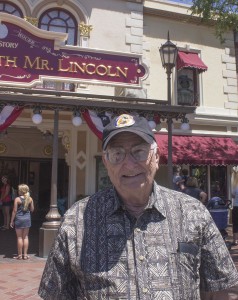
John Waite, a Disneyland Alumni, worked in an office in the Opera House way before Great Moments with Mr. Lincoln showed up.
While in the Studio’s publicity department he frequently worked with Van France, later the co-founder of the Disneyland Alumni Club, who was working in Disneyland’s personnel department organizing the training for new Cast Members.
When he learned that John really wanted to work at Disneyland, Van told him about the new Holidayland area they were creating for big corporate and other group events. The head of the studio’s personnel department thought John was making a mistake, but he still wanted to transfer to Disneyland and in 1957, John went to work for Van.
One of the first things he did was help put together the first event for Holidayland—an area in what is now New Orleans Square—for corporate and large events. The first event, a picnic for 5,000 people, featured a full meal, liquor, and a full slate of Disneyland entertainment, including the Disneyland Band, Indian dancers from the Indian Village (located in what is now Critter Country), Golden Horseshoe entertainers Betty Taylor and Wally Boag, and the Mickey Mouse Club. Attendees also got tickets into Disneyland. Despite all the entertainment and all the games set up, after everyone ate, no one stayed in the land. “They all went into the park to ride the rides,” John said.
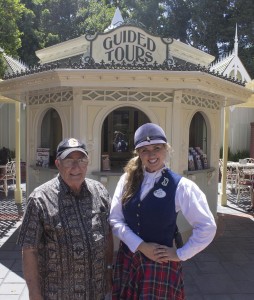
John Waite, a Disneyland Alumni, is pictured with Chantel, a current day Tour Guide at Disneyland. John helped initiate and led tours on the first day they were offered in the early days of Disneyland.
Next Van volunteered John to help out with the first trial run of guided tours. They came up with spiels and costumes for a planned test run to see if people would like them, and more importantly, pay for them. “The first day they offered the guided tours, 90% of the gate paid for them. We were supposed to have 15 people in a group; we ended up having to have 50 people in a group,” John said.
Thanks to Van, John was also called upon to play Mickey Mouse out in the park at times. “They didn’t have a character department at the time. They did parades and shows, but when dignitaries came and wanted photos with Mickey and Minnie, they needed someone, I was one of the ones elected.” John also played Mickey Mouse at one of the first Disney nights at the Hollywood Bowl.
Van left Disneyland after a couple years to help Joe Fowler, another Disney legend, with Freedomland, a park Joe was building back east. John wasn’t happy when Van left, so he also left and went to work for UCLA’s Central Stage Management group, where they handled all the public events on campus. “My leaving Disneyland as a full-time employee was so sad.”
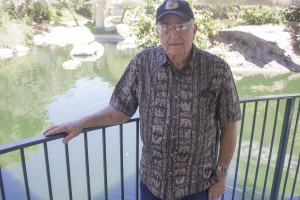
John Waite, a Disneyland Alumni, is pictured on the dock of the location of the Motorboat Cruise attraction. John worked the attraction in its first days of operation in the 50s.
John worked at UCLA for 10 years, but during that time he worked summers at Disneyland on attractions like the Jungle Cruise, Matterhorn, and even a short stint on the Peoplemover. He did this until 1969. His heart was still with theme parks, and as John looked around for more opportunities, he found it in the new log flume technology being developed by Arrow Development for Six Flags. “I thought it would be great for Knott’s Berry Farm.”
John went to Six Flags Over Texas for several days to study the ride, then, while still at UCLA, developed a log flume concept that he planned to pitch to Knott’s. “It was a log ride concept, with a hydro-mining theme.”
John wrote to Walter Knott saying he had a ride proposal. A few days later Russell Knott, Walter’s son, called and asked John to come in for a meeting. “We met, and he told me that they didn’t do the designing of rides at Knott’s. He knew they were working on a log ride with Bud Hurlbut, but didn’t say anything.”
(Editor’s note: Bud Hurlbut is a legend in the theme park business. His ideas and attractions even influenced Walt Disney, who spent several days studying the Calico Mine Train Ride and in Bud’s shop, which was located just north of Knott’s Berry Farm.)
Russell set up an appointment for John with Bud, who designed many of Knott’s Berry Farm’s rides. John showed Bud his idea. “Bud laughed and said he wanted to show me something. He took me into his shop and showed me the models of the log ride he was building for Knott’s. I had to laugh too, but then I asked him for a job.”
Bud wasn’t hiring at the time, but offered John a job as a skipper on the steamboat that plied the lagoon at Knott’s. But John really wanted to work on the log ride construction. So John resigned from UCLA after the 1969 commencement exercises and went to work for Bud. “I worked on some of the final preparations of the ride, sealing cracks and things like that.” John became one of the Timber Mountain Log Ride’s supervisors and worked on it, and for Bud, for many years.
Now retired, John still loves theme parks and their rides. At the age of 85 he has passes for Disneyland and Knott’s and can frequently be seen at both of the parks.
“I love the rides and the people that work there. It’s always nice to go, sometimes just to watch the people having a good time.”
This profile is part of a series featuring former Disney Cast Members being written for the Disneyland Alumni Club. These stories reveal the role working for Disney has played over the years in shaping the lives of the people who help “make the dream a reality,” as Walt would say.
In honor of the 60th anniversary year of Disneyland in 2015, the Disneyland Alumni Club is reaching out to former employees, whether retired or younger, who may not be aware of the organization. The Club was started in 1983 by Disneyland executives Van France and Dick Nunis as a way to help Cast Members stay in touch after moving on to other careers. Is that you? If so and you’d like to take part in the Club’s private celebration next August—or participate in their many other activities and benefits, please visit www.disneylandalumni.org and join today!
Want to read articles about some other Disneyland Alumni? Click on the links below.
Lifelong bonds formed working at Disneyland
Caretaker of Walt Disney’s Family Film Legacy
This article and photographs are copyright 2014 by Mark Eades, all rights reserved. Used by permission. Photographs supplied by subjects are used by permission, all rights reserved.
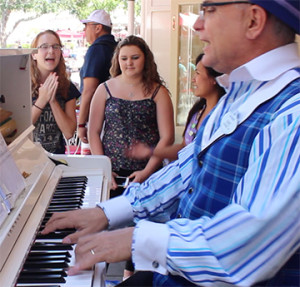
These three girls sang an impromptu performance of “Let It Go” from the Walt Disney Animation film “Frozen” at Disneyland’s Coke Corner with the Ragtime Pianist.
I was meeting a friend at Disneyland today, when I heard the familiar refrain of “Let it Go” coming from Coke Corner.
I wandered over in time to hear three teenage girls singing the song with the ragtime pianist.
So I got out my camera and started shooting.
Enjoy.
What is it about Disneyland that for those who worked there, they form lifelong bonds?
Is it from the pixie dust they throw on you at orientation when you start working as a Cast Member at the “Happiest Place on Earth?” Is it the camaraderie from working side by side with others, all of whom are smiling most of the time? Or is it Walt Disney’s spirit of optimism, still handed down to succeeding generations by Cast Members nearly 60 years after the park first opened in 1955?
Those bonds were recognized by two key Disneyland Cast Members, Van Arsdale France (who founded the Disney University) and Disneyland Executive Dick Nunis. They saw the need to help Cast Members stay connected after they left the park. This led them to form the Disneyland Alumni Club in 1983.
The Club has both a mission and a motto. Its motto is: Always part of the magic! Its mission: To preserve, honor and perpetuate the values, traditions and outlook upon which Disneyland was created.
As the Club gears up for its own celebration of Disneyland’s 60th birthday next year, the Club’s Board of Directors felt it was time to make some changes, just like Walt Disney said Disneyland would change, the Club saw a need to change how it operates; to become more of a special organization to which all Cast Members can belong to and participate.
One of the things the Club wants to do is explore those special bonds between Cast members, and to take a look back at some of the fun things they remember from working at the park.
One example is how many of us found our life mates while working at the park and are still together with them. Yet another is how new succeeding generations of Cast Members are working at the park their parents worked.
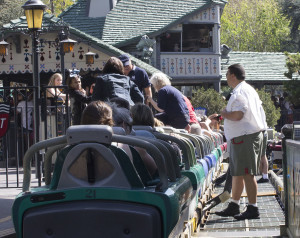
A Disneyland cast member working on the Matterhorn Bobsleds, keeps a watchful eye on park guests exiting their bobsleds after a ride down the mountain.
To help collect those special memories, the club is going to create a forum to tell those stories and others like: How did they end up working at Disneyland? What different roles did everyone have in their careers there? Another is how that spirit led many to work together in charities, some formed by Cast Members themselves.
The board knows that many current and former Cast Members are also Disneyland fans, and frequently visit the park. But it should be noted that, unlike some Disneyland fan websites, this is not about bashing the park. It is meant to show the fun side of working there, and how it affected later careers in a positive way.
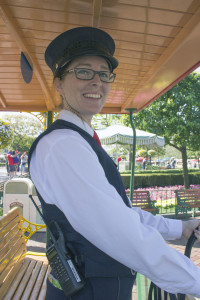
Alyssa, a cast member working on the Main Street U.S.A. Horse Trolley line, prepares to guide her horse down the street from the hub.
With that in mind, we invite all current and former Disneyland Cast Members to send us their fun, positive stories. Those stories can be sent via email to: info@disneylandalumni.org, or via snail mail to: Disneyland Alumni Club, P.O. Box 17280, Anaheim, CA 92817. You can also email the author, Mark Eades, at: markaeades@aol.com – please put “Disneyland Alumni Club” in the subject line if emailing the author.
There will be also be more information upcoming about the Club’s monthly meetings and events coming up, as well as details on the Club’s own celebration of Disneyland’s 60th birthday, to be held on August 1, 2015 at the Disneyland Hotel. Look for weekly stories and more as things come in in the weeks and months to come.
Want to read articles about some other Disneyland Alumni? Click on the links below.
Caretaker of Walt Disney’s Family Film Legacy
Important legal notice if emailing stories or photos:
This release and disclaimer applies to You if You submit stories, or agree to be interviewed for a story, to the Disneyland Alumni Club, Inc. (“Club”) or to Mark Eades for use on the club’s web site or elsewhere, such as Mark Eades’ web site.
In consideration of Your submitting stories, or being interviewed for a story, for use on the Club web site or elsewhere, You agree to release, covenant to indemnify and hold harmless; the Club or any persons authoring or publishing such stories from all liability of any kind whatsoever, and from any and all loss or damage or any claim or demand resulting from any activity of any kind by the Club or any persons authoring such stories for use on the Club web site or elsewhere, whether caused by negligence or otherwise. You assume all liability in connection with Your submission of any stories, including stories created following an interview with You, upon submitting Your stories or participating in an interview.
The Club will make reasonable efforts to review the stories, including stories that result from an interview, with You prior to publication so that You may comment upon them or suggest changes.
You also agree that you have the right to any photos or articles submitted to the Club, and grant the Club and its representatives, including Mark Eades, an indefinite release to use them.
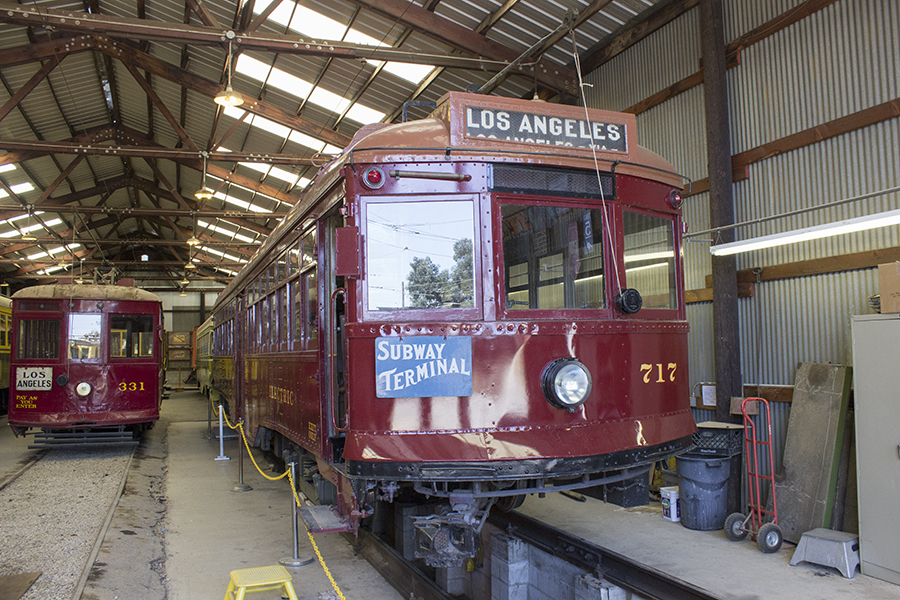
This Pacific Electric Red Car #717 is operational at the Orange Empire Railway Museum in Perris, CA. It has appeared in many movies including “Who Framed Roger Rabbit?” Photo by Mark Eades
Do you recognize this Pacific Electric Red Car? If you’re a Disney fan you should. It was used in the movie “Who Framed Roger Rabbit?”
It also still runs many weekends at the Orange Empire Railway Museum in Perris, California.
That same Red Car and many others are housed at the outdoor museum, and were the inspiration for the Red Cars seen at Disney California Adventure.
The museum was started by a group of men concerned that the Red Cars were disappearing in the fifties. The group began as the Electric Railway Historical Association of Southern California and immediately went to work collecting what they could of the old system that used to serve much of Los Angeles and Orange Counties.
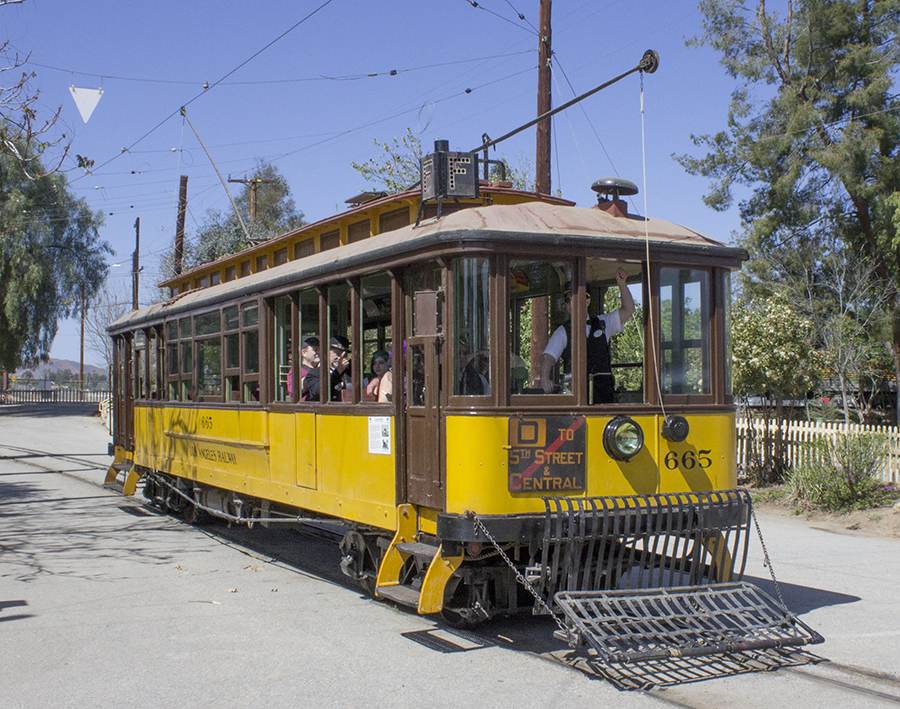
An electric streetcar from the Los Angeles Railroad plies the narrow-gauge rails at the Orange Empire Railway Museum in Perris, CA. Photo by Mark Eades
The growing collection was initially housed at Travel Town in Griffith Park, but when the Ventura Freeway was going to claim some of that land, the group purchased the land in Perris and moved it there in 1958.
Named the Orange Empire Railway Museum, it collecting more and more railroad-related items including steam engines, cabooses, diesels, various cars, more Red Cars and other trolleys and more.
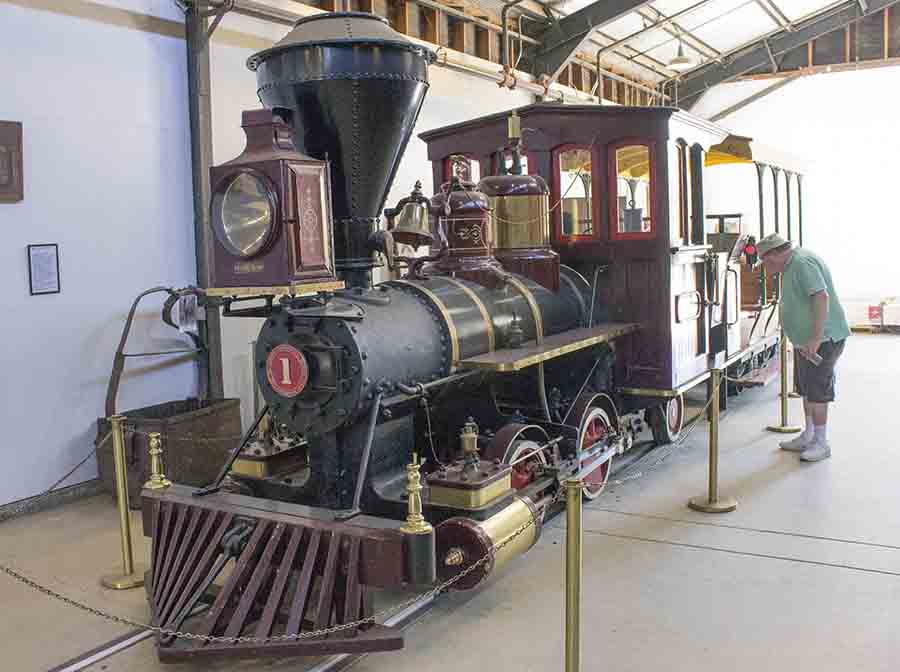
This steam locomotive belonged to Ward Kimball, one of Walt Disney’s “nine-old-men.” Ward arranged for the locomotive and its passenger car to be donated to the museum upon his death. The family retained the locomotive for a number of years. The steam engine was originally used on a sugar plantation. It has no actual brakes. Photo by Mark Eades
Among the steam engines at the museum are two related to Disney – they once belonged to Ward Kimball, one of Walt Disney’s nine-old-men of animation.
Ward owned two engines, some passenger cars and other train-related items that used to run on tracks at his home in San Gabriel.
He donated money for a barn named after his railroad at the museum, and designated it to receive his collection.
As you can see in the photos, the Grizzly Flats Railroad equipment still lives. The smaller engine, the Chloe, does not have a brake system, so the museum does not try to operate it.
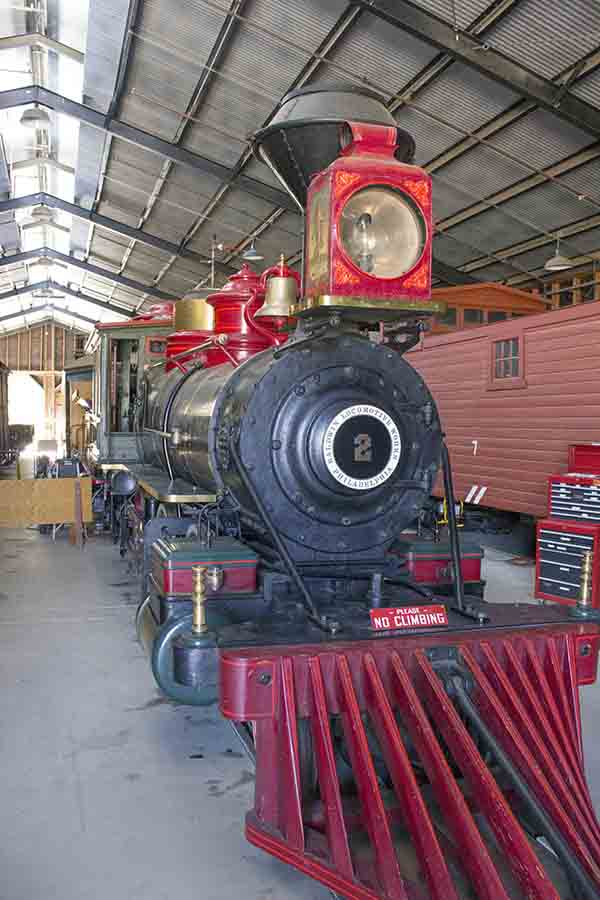
This steam engine belonged to Ward Kimball. It was built in 1881 by the Baldwin Locomotive Works. It is a 2-6-0 Mogul type. Brakes were added in 1901. It weighs 44,000 pounds. The tender weighs 20,000 pounds. The Orange Empire Railway Museum is looking for donations to help pay for its restoration. Photo by Mark Eades
The larger engine, the Grizzly Flats/Nevada Railroad #2, however, does and the museum is seeking donations to get it back into running condition with its other operational engines on the rails.
The museum is run by an all-volunteer staff, and members can learn how to do almost anything, including becoming an engineer for a steam locomotive – though that takes years to get certified by the state.
The museum is located at: 2201 South A Street, Perris, CA 92570.
You can find out more about the museum, including when its rolling stock will be operating (usually weekends) on its website, oerm.org.
